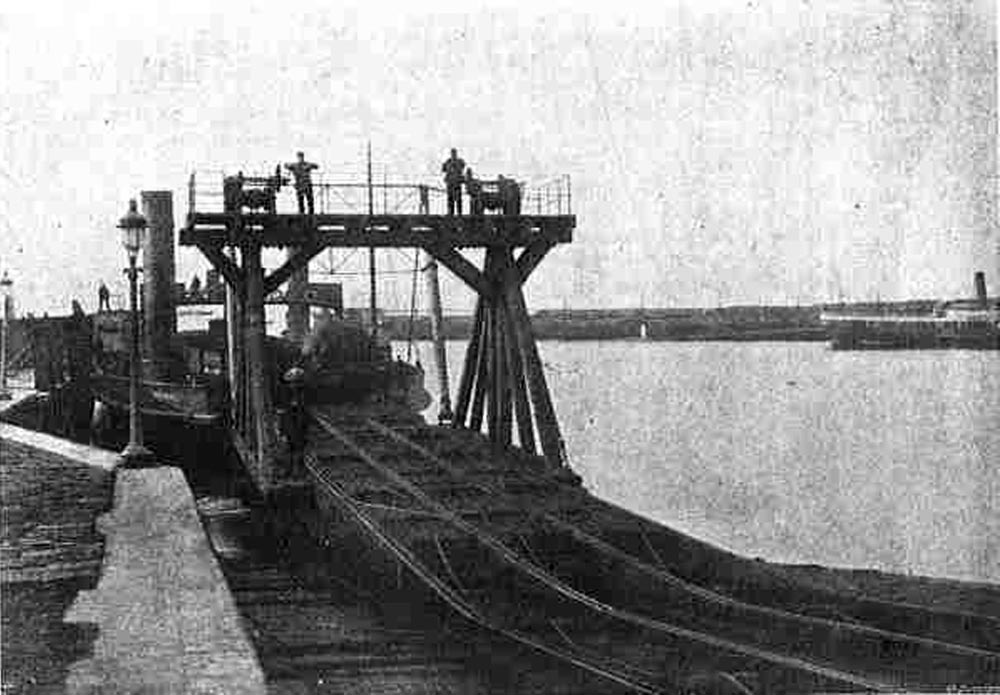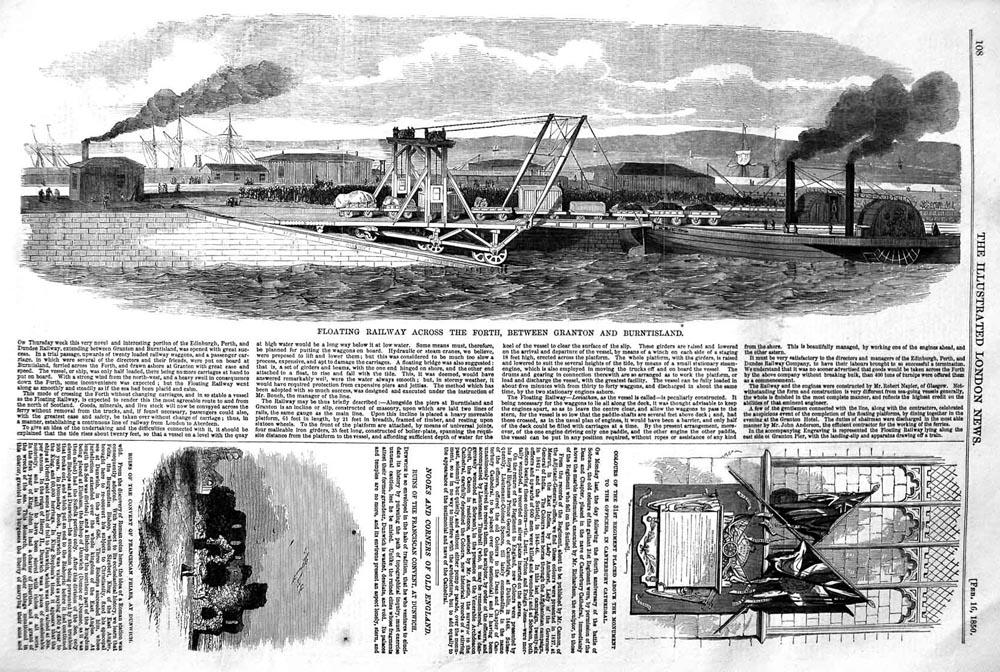1850 – Burntisland to Granton Floating Railway
| < Anderson’s Chain Bridge | Δ The Queensferry Passage | The Charlestown Bridge > |
Thomas Bouch became a railway engineer at the age of seventeen, and by the age of twenty-six, had risen to become Manager and Chief Engineer of the Edinburgh and Northern Railway. His principal remit was to update the ferry service, in line with the rapidly-developing railway system. In January 1850, he introduced the innovative train ferry – the “Leviathan” – on the Burntisland-Granton run.
This ferry was a great success and continued in operation until the opening the Forth Bridge in 1890
The Illustrated London News February 16 1850
Floating Railway across the Forth between Granton and Burntisland
Transcript
On Thursday week this very novel and interesting portion of the Edinburgh Perth and Dundee Railway, extending between Granton and Burntisland, was opened with great success. In a trial passage, upward of twenty loaded railway waggons, and a passenger carriage in which were several of the directors and their friends, were put on board at Burntisland, ferried across the Forth, and drawn ashore at Granton, with great ease and speed. The vessel or ship, was only half loaded, there being no more carriages at hand to put on board. With a strong wind from the north-west, and a heavy swell in consequence down the Forth, some inconvenience was expected; but the Floating Railway went along as smoothly and steadily as if the sea had been placid and calm.
This mode of crossing the Forth without changing carriages, and is so stable a vessel as the Floating Railway, is expected to render this the most agreeable route to and from the north of Scotland. Goods, minerals, and live stock will now be conveyed across the ferry without removal from the trucks, and, if found necessary, passengers could also with the greatest ease and safety, be taken over without change of carriage; thus in a manner, establishing a continuous line of railway from London to Aberdeen.
To give an idea of the undertaking and the difficulties connected with it, it should be explained that the tide rises about twenty feet, so that a vessel on a level with the quay at high water. Some means must therefore be planned for putting the waggons on board. Hydraulic or steam cranes, we believe were proposed to lift and lower them; but his was considered to be much too slow a process, expensive, and apt to damage the carriages. A floating bridge was also suggested; that is a set of girders attached to a float to rise and fall with the tide. This, it was deemed, would have answered remarkably well were the water always smooth; but, in stormy weather, it would have required protection from expensive piers and jetties. The method which has been adopted with so much success was designed and executed under the instruction of Mr Bouch, the manager of the line.
The Railway may thus be briefly described: — Alongside the piers at Burntisland and Granton is an incline or slip, constructed of masonry, upon which are laid two lines of rails, the same gauge as the main line. Upon this incline is placed a heavy moveable platform 61 feet in length by 21 feet in breadth, framed of timber, and resting upon sixteen wheels. To the front of the platform are attached, by mean sod universal joints, four malleable iron girders 35 feet long, constructed of boiler-plate, spanning the requisite distance from the platform to the vessel, and affording sufficient depth of water for the keel of the vessel to clear the surface of the slip. These girders are raised or lowered on the arrival and departure of the vessel, by means of a winch on each side of a staging 18 feet high, erected across the platform. The whole platform with the girders is raised or lowered to suit the several heights of the tide, by means of a small stationary steam-engine, which is also employed in moving the trucks on and off the vessel. The drums and gearing in connection therewith are so arranged as to work the platform, to load and discharge the vessel, with the greatest facility. The vessel can be fully loaded in about five minutes with from thirty to forty waggons, and discharged in about the same time, by the two stationary engines ashore.
The Floating Railway – Leviathon as the vessel is called – is peculiarly constructed. It being necessary for the waggons to lie all along the deck, it was thought advisable to keep the engines apart, so as to leave the centre clear, and allow the waggons to pass to the stern, for the vessel is so low that the paddle shafts are several feet above deck; and, had these crossed, as in the usual plan of engines, it would have been a barrier, and only half of the deck could be filled with carriages at one time. By the present arrangement, moreover of one engine driving only one paddle, and the other engine the other paddle, the vessel can be put in any position required, without ropes or assistance of any kind from the shore. This is beautifully managed, by working tone of the engines ahead and the other astern
It must be very satisfactory to the directors and managers of the Edinburgh, Perth and Dundee Railway Company, to have their labours brought to so successful a termination. We understand that it was no sooner advertised that goods would be taken across the Forth by the above company without breaking bulk, than 400 tons of turnips were offered as a commencement.
The Railway and the engine were constructed by Mr Robert Napier, of Glasgow. Notwithstanding the form and construction is very different from sea-going vessels generally, the whole is finished in the most complete manner, and reflects the highest credit on the abilities of that eminent engineer.
A few of the gentlemen connected with the line, along with the contractors, celebrated the auspicious event of the completion of the floating platform by dining together in the evening at the Granton Hotel. The duties of chairman were discharged in the most able manner by Mr John Anderson, the efficient contractor for the working of the ferries.
In the accompanying Engraving is represented the Floating Railway lying along the east side of Granton Pier, with the landing-slip and apparatus drawing off a train.

Some more images of the Train Ferry
 The “Leviathon” at Granton Dock
The “Leviathon” at Granton Dock
 The “Leviathon”
The “Leviathon”
 The “Leviathon”
The “Leviathon”
The Queensferry Question
In 1851, Thomas Bouch failed to persuade the the Edinburgh Perth and Dundee Railway to introduce a similar systems at the Queensferry Narrows. So, he turned his attention to bridges across the Tay and Forth estuaries. When his suggestions failed to gain traction with the company he quit and set up a private consultancy firm. One of his proposals was a railway bridge from Charlestown to Blackness.
| < Anderson’s Chain Bridge | Δ The Queensferry Passage | The Charlestown Bridge > |
